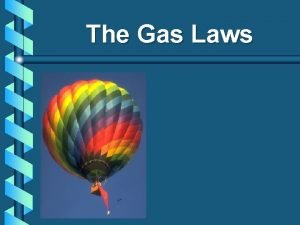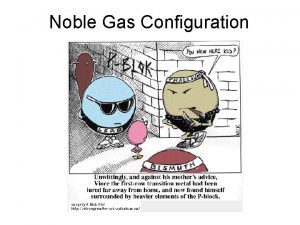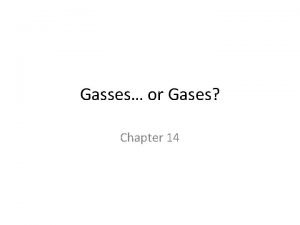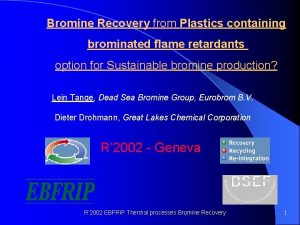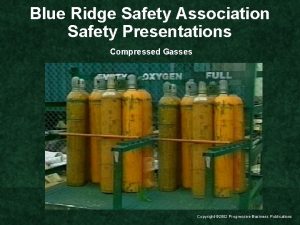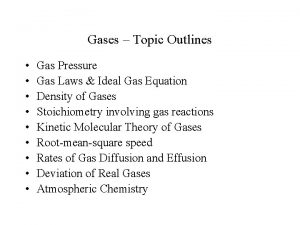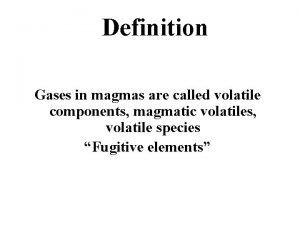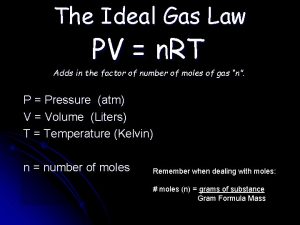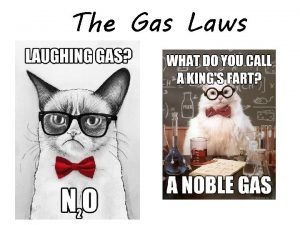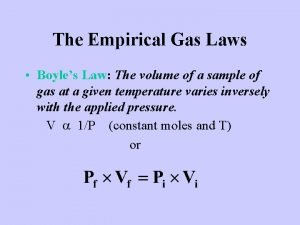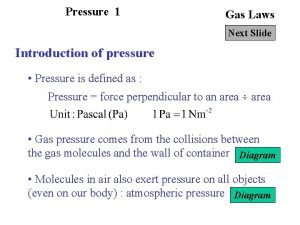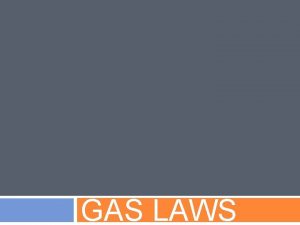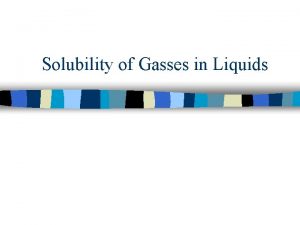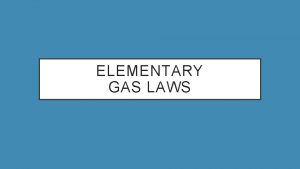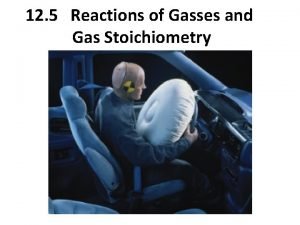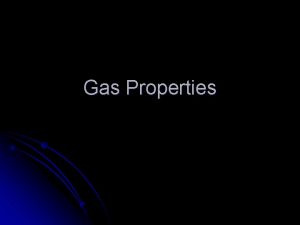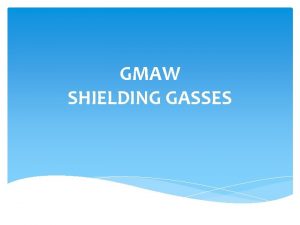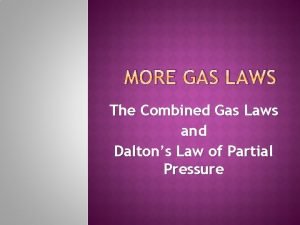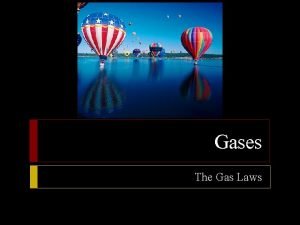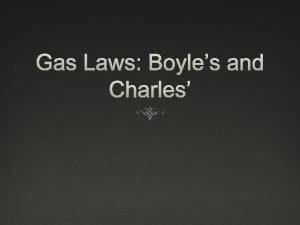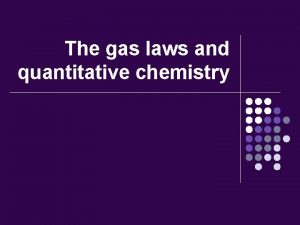GAS LAWS Gas Laws As you recall gasses















- Slides: 15

GAS LAWS

Gas Laws As you recall, gasses have no fixed shape or volume However, the relationship between the pressure, volume, and temperature of a gas holds true for all gases. Because gases behave in a similar way thru a wide variety of conditions because they all have molecules which are widely spaced Because of this, we have laws that can explain the way gasses will act under certain conditions

Gas Laws So, we have 3 GAS LAWS: Boyle’s Law Charle’s Law Gay-Lussac’s Law For each law, one condition is held constant, while the other two conditions will change Conditions of Temp, Pressure, Volume

Gas Laws: The Equation P 1 V 1 = P 2 V 2 T 1 T 2 Using this equation, you can solve for temperature, pressure, and volume. The thing that is being held constant in that problem is just ignored from the equation We will look at that more later.

Gas Laws: Background Info / Units Standards that you need to understand for all work with gas laws: (I will give you these on the test) TEMPERATURE: Kelvin will always be used in Gas Laws PRESSURE: Caused 1 by atoms colliding with container atm VOLUME: L (at least one of them will be easy to remember)

What is atmospheric pressure? Each particle of air held in place by gravity collides with and exerts a force against you and everything around you creating air pressure. The closer you are to sea level, the more pressure acting on you. The higher the altitude, the less gravity, and therefore the less pressure acting on you.

Boyles’ Law We know that P 1 V 1 = P 2 V 2 T 1 T 2 If the temperature remains constant, the volume and pressure vary inversely Simply if Pressure ↑, then Volume↓ And vice versa If temperature is constant, ignore it in the formula P 1 V 1 = P 2 V 2

Boyles’ Law REAL WORLD EXAMPLES A syringe: as you are trying to take blood and pull back on the plunger, the air volume in the syringe increases, decreasing pressure. The decrease in pressure causes blood to enter into the syringe Air bubbles increase in size as they work they travel from deep water to shallow water. Your ears popping in high altitude situations (in an airplane). Deep sea creatures dying when they are brought to the surface (and scuba divers getting the bends) MARSHMALLOW DEMO!!!

Charles’ Law We know that P 1 V 1 = P 2 V 2 T 1 T 2 If the pressure remains constant, the volume and temperature vary directly Simply if Temp ↑, then Volume ↑ And vice versa If pressure is constant, ignore it in the formula = V 1 V 2 T T

Charles’ Law REAL WORLD EXAMPLES Your car tires will “deflate” on the first very cold morning. It doesn’t lose air, but the air is taking up less space. A basketball that would bounce in the summer does not bounce well anymore in the winter. Hot air balloons float because when air is heated, it takes up more volume. More volume with the same amount of air means it is less dense than the air around the hot air balloon. DEMOS!!! - Balloon on a Bottle Demo!!!!

Gay-Lussac’s Law We know that P 1 V 1 = P 2 V 2 T 1 T 2 If the volume remains constant, the temperature and pressure vary directly Simply And if Pressure ↑, then Temp ↑ vice versa If volume is constant, ignore it in the formula = P 1 P 2

Gay-Lussac’s Law REAL WORLD EXAMPLES q q A cannonball shooting out of a cannon. Cannon barrell shape (volume) is constant. When gun powder is ignited, the temperature rises sharply and substantially. This increases pressure until the cannonball is launched from the cannon. An aerosol can exploding when it is close to flames. The can stays the same volume, so as temp increases, pressure increases, until BOOM! q A propane tank exposed to VERY hot temperatures would do the same thing. DEMOS: Egg in a flask, candle in a beaker, can

Gay-Lussac’s Law Popcorn popping…

Solving Gas Law Problems Figure out which law you are dealing with The law you are dealing with will dictate which variable you ignore Write out your known values and your formula Insert your known values into your formula Solve for the variable

Recap • And how do I remember which law keeps which variable constant? Big Tigers Can Play Golf Violently • Boyles’ Temp is Constant Charles Pressure is Constant Gay-Lussac’s Volume is Constant • Remember to think about your popsicle stick! • •
 A gas occupies 473 cm3 at 36°c. find its volume at 94°c
A gas occupies 473 cm3 at 36°c. find its volume at 94°c How many elements are gasses at room temperature
How many elements are gasses at room temperature Electron configuration for noble gases
Electron configuration for noble gases Gasses or gases
Gasses or gases Gasses
Gasses Gasses
Gasses Blue gasses
Blue gasses Charles's law
Charles's law Magma volatile gasses definition
Magma volatile gasses definition Useless laws weaken the necessary laws
Useless laws weaken the necessary laws Gas laws crash course
Gas laws crash course Constant direct indirect relationship
Constant direct indirect relationship Empirical gas laws
Empirical gas laws Combined gas law formula
Combined gas law formula Bourdon gauge gas law
Bourdon gauge gas law Different gas laws
Different gas laws
